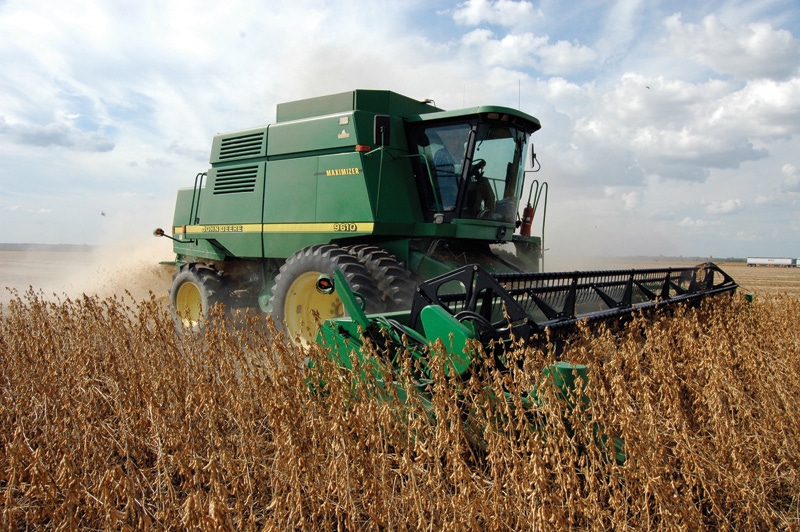August 17, 2018

Worldwide demand for U.S. soybeans remains strong in the midst of a trade war, and China still needs America’s soybeans, according to an LSU AgCenter report on trade tensions with China.
“There are, as yet, no signs of slowing global demand for U.S. soybeans, which is positive,” the report says.
In the short term, China will continue to buy U.S. soybeans at a reduced volume, even with the tariffs, but a bigger reduction is likely if the continued conflict becomes a long-term, according to the report.
Soybean prices have fallen by 20 percent since the first shots were fired in the trade war in April, and that decline has wiped out profits for many Louisiana soybean farmers, said LSU AgCenter economist Mike Deliberto, who co-wrote the report with AgCenter economist Kurt Guidry and AgCenter research associate Brian Hilbun.
Louisiana soybean farmers have to sell their crop for $7.20 to $9.27 a bushel, depending on whether they have more expensive irrigation costs, to cover production costs, Deliberto said.
Prices will struggle
If the projections by the U.S. Department of Agriculture are correct, the 2018 American soybean crop will boost ending stocks, which will result in lower prices. “Prices will struggle to get above that $9.50 mark,” he said.
China imports roughly $20 billion in U.S. agricultural commodities annually, including 60 percent of U.S. soybeans. About 57 percent of the Louisiana crop is sold to China.
The USDA has projected a price range of $7.65 to $10.15 per bushel for the next year, with $8.90 per bushel as the midpoint. The August World Supply and Demand Estimates report increased domestic production on higher forecasted yields. Ending stocks are projected to be up from the July report and 83 percent greater than 2017-18 ending stock levels.
“Sales outside of China are looking pretty good right now,” Deliberto said.
Lower soybean prices, partially resulting from Chinese tariffs, have contributed to an increase in soybean imports by the European Union from the U.S.
China’s appetite for soybeans increased as its growing, more-affluent population consumed more meat, requiring more soybeans as a food source for livestock. “With Chinese hog production and domestic meat consumption rising, it needs more protein meal, all at a time when soybean meal consumption in the rest of the world is also increasing,” the report says.
Talks with China
It’s impossible to predict how long the trade conflict will last, but it’s encouraging that talks with China have begun, Deliberto said.
For this year’s crop, many farmers were able to contract their soybeans ahead of time to lock in prices above $10. “Those $10 prices have definitely come off the board,” Deliberto said.
The administration’s $12 billion program to compensate U.S. soybean farmers, along with producers of sorghum, wheat, cotton, dairy and pork, requires no congressional action. “We really don’t know how the money will be allocated, as details have not yet been released,” he said.
The plan includes direct payments to farmers, trade promotion and government buyouts of surplus agricultural goods to offset the tariffs.
There also are concerns among some policymakers in Washington that the $12 billion program could prompt other countries to file a complaint with the World Trade Organization that the U.S. government is artificially subsidizing producers, the same way Brazil filed a WTO complaint against the U.S. in 2004 that led to changes in the cotton program in the 2014 farm bill, Deliberto said.
Bumper Brazilian crop
Brazil is having a bumper soybean crop this year, but Brazilian soybeans carry a $47-per-ton premium. The report also says that Brazil’s infrastructure complicates getting harvested soybeans to shipping facilities.
The fallout in agriculture from the trade war affects more than farmers, with the resulting uncertainty possibly causing economic pain for agricultural lenders, landowners and equipment dealers, the report says.
The report also details possible ramifications of the tariffs on the New Orleans Ports Region, which includes New Orleans, Baton Rouge, Avondale, St. Rose, Gramercy and Destrehan. The facilities ship 59 percent of U.S. soybean exports, according to the report.
“Given the volume and make-up of trade flows through NOPR, any slowdowns and/or disruptions to normal trade patterns with China could have a significant financial impact,” the report says.
Meanwhile, Chinese rice has been sold to Puerto Rico in recent months, although American rice cannot be sold to China.
Bobby Hanks, chairman of the USA Rice International Trade Policy Committee and president of the Supreme Rice mill in Crowley, said that’s not fair.
“USA Rice supported the administration’s initial action to increase import duties on rice from China,” Hanks said. “We can’t ship U.S. rice to China, yet China is shipping increasing amounts of rice to the United States.”
USA Rice, with the support of successive U.S. administrations, has sought for more than a decade to obtain approval from the Chinese government to import U.S. milled rice.
Despite signing a phytosanitary agreement last July and positive follow-up this summer, progress has stalled. In the meantime, imports of rice from China have soared to triple the volume in 2017 versus 2016, and up 75 percent against in the first five months of 2018. Most of these imports are shipped to Puerto Rico.
“We were ready before the president’s instruction to recommend that imports of rice from China face an additional duty of 25 percent, and we will do so as part of the formal comment period,” Hanks said. “We have long sought normal commercial relations with China, but that means reciprocal fairness. And we have neither right now.”
You May Also Like




